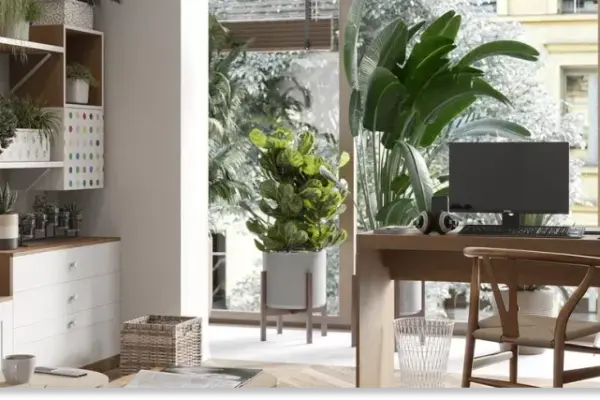Imagine how your mood transforms when sunlight plays on the leaves of houseplants! Modern humans spend up to 90% of their time indoors, gradually losing the vital connection with nature. Biophilic interior design is revolutionizing this by creating spaces where natural elements in design become an integral part of your everyday environment. Eco-friendly interior design is not just a fashion trend, but a scientifically based concept that relies on the deep biological need of humans to connect with living nature.
Integrating nature into the interior through biophilia principles amazingly transforms the quality of life: it creates a healthy microclimate in the home, noticeably reduces everyday stress levels, and significantly improves cognitive functions. Natural materials in interiors and natural room design form a space where a person intuitively feels protected and inspired. Biophilia at home is manifested not only through living elements in design but also through textures, lighting, and color solutions. Let's consider the basic principles, practical techniques, and proven benefits of using biophilic solutions for the home in modern conditions.
What is Biophilic Design and Why It Matters
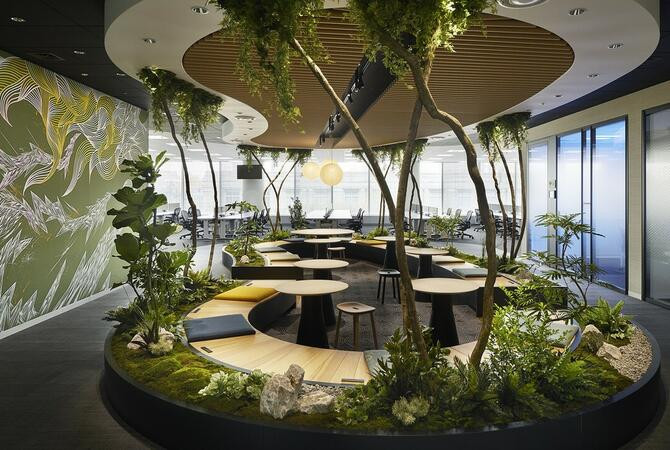 Biophilic design is a concept of creating spaces using natural materials, natural elements, and organizing an environment that imitates or includes natural processes. The term "biophilia" was introduced by biologist Erich Fromm and means "love of life" or "love of living systems".
Biophilic design is a concept of creating spaces using natural materials, natural elements, and organizing an environment that imitates or includes natural processes. The term "biophilia" was introduced by biologist Erich Fromm and means "love of life" or "love of living systems".
Eco-friendly interior design is built on three main principles:
- Direct contact with nature (plants, water, natural light)
- Indirect contact (natural materials, textures, colors)
- Spatial characteristics (panoramic views, shelters, spaces for exploration)
Including these elements in the interior creates an environment where a person feels comfortable on an intuitive level.
"Biophilic design is something more than just aesthetics. It's a deep connection to our evolutionary history that helps us feel protected and simultaneously inspired. Interiors created with biophilia principles in mind contribute to the restoration of mental and physical balance in our technological world."
Key Principles of Biophilic Design
.jpeg) Let's look at the main elements that form a harmonious nature-oriented interior design:
Let's look at the main elements that form a harmonious nature-oriented interior design:
- Natural lighting in design — Maximizing the use of daylight is a cornerstone of biophilic interior. Large windows, skylights, glass partitions, and mirrors help increase access to natural light, which effectively regulates human circadian rhythms and positively affects mood.
- Plants in interior — Living plants represent the most obvious way to integrate nature into the interior. They not only purify the air but also create a powerful visual connection with the natural world. Vertical greening of premises, hanging gardens, large plants in tubs — all these techniques help bring life into the interior.
- Natural materials — Furniture made of natural materials, natural wallpaper for the home, wooden surfaces, stone, clay, bamboo, and other natural textures in design create a rich tactile and visual diversity reminiscent of the natural environment.
- Organic forms and biomimicry — The imitation of natural processes in design through flowing lines, asymmetry, and irregular shapes contrasts with the strict geometry of traditional interiors. The historical roots of this approach can be found in the expressionist architecture of the early 20th century, where biomorphic elements first became the foundation of artistic concepts. Biomimicry in interior design involves using natural patterns such as honeycomb structures, spirals, or fractal motifs.
- Water elements — Fountains, aquariums, decorative waterfalls add dynamic movement, play of light, and acoustics of natural sounds, which significantly enriches the perception of space and creates a calming effect.
- Natural color palettes — Using colors inspired by nature — from warm earthy tones to fresh shades of sky and vegetation, creates a harmonious, visually comfortable atmosphere that reduces psychological tension.
Applying these principles in combination allows creating a space that not only looks aesthetic but also has a real positive impact on physical and emotional health.
For those who are skeptical about the idea of biophilic design, it's worth getting acquainted with scientific research on biophilia. Meta-analysis shows that the impact of natural elements on humans has a biological basis and is expressed in measurable psychological and physiological reactions.
Benefits of Biophilic Design
 Eco-friendly space design with elements of biophilia in the interior has many scientifically proven benefits:
Eco-friendly space design with elements of biophilia in the interior has many scientifically proven benefits:
Let's consider the scientifically proven benefits of integrating nature into the interior through biophilic design:
| Benefit | Manifestation | Research |
|---|---|---|
| Psychological well-being | Reduced levels of stress, anxiety, and depression | 15% higher in spaces with biophilic elements |
| Physical health | Improved air quality, reduced illness | Up to 20% fewer sick days |
| Productivity | Increased concentration and creative thinking | Growth of 6-15% in work environments |
| Cognitive functions | Better memory, learning, and decision-making | Improvement in indicators by 10-25% |
| Healthy microclimate at home | Regulation of humidity, temperature, and air quality | Reduction of toxin levels by 30-60% |
As can be seen from the table, biophilic design is not only aesthetically pleasing but also notably improves quality of life at the physiological level, creating a favorable environment for living and working.
Sustainable interior design using biophilic elements is becoming increasingly popular not only in private homes but also in commercial premises, hospitals, and educational institutions due to its positive impact on people.
How to Implement Biophilia in Interior Design
 Creating a connection with nature in the interior is accessible for any space and budget. Regardless of the size of your dwelling, there are always ways to integrate natural elements that will transform the atmosphere and quality of life in it.
Creating a connection with nature in the interior is accessible for any space and budget. Regardless of the size of your dwelling, there are always ways to integrate natural elements that will transform the atmosphere and quality of life in it.
Small Spaces
Even in small apartments, you can create a biophilic apartment design. Use compact plants, photo wallpapers with natural motifs, small fountains, and furniture made of natural wood. For small spaces, it's particularly important to properly place mirrors that increase access to light.
Kitchen and Bathroom
In the kitchen, prefer stone countertops, wooden facades, and living plants (such as herbs). In the bathroom, create a spa atmosphere with a pebble floor, wooden accessories, and plants that tolerate humidity well.
Living Room and Bedroom
In these rooms, the priority should be natural lighting in design and quality natural materials for finishing and furniture. Large plants, natural textures, and warm tones will create an atmosphere of comfort and tranquility.
"When implementing biophilic elements, it's important to remember about authenticity. Natural materials should be genuinely natural, not imitations. Each element should evoke the same feelings as being in a natural environment. When the connection with nature in the interior is felt intuitively, without deliberate indications — that's when biophilic design truly works."
Work Spaces
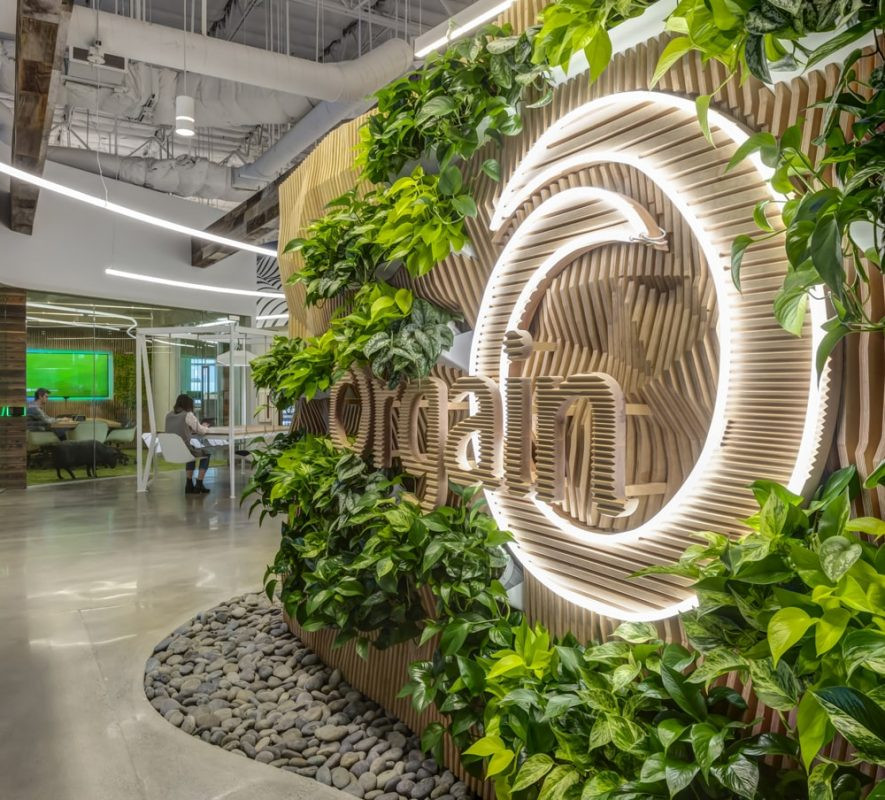 Biophilic design for office spaces should include zones with various degrees of privacy, visual access to nature or its elements, and sufficient natural lighting. Plant walls in office interiors have become an effective solution for large spaces.
Biophilic design for office spaces should include zones with various degrees of privacy, visual access to nature or its elements, and sufficient natural lighting. Plant walls in office interiors have become an effective solution for large spaces.
Modern architects and designers actively apply biophilia principles in large-scale projects. Getting acquainted with outstanding examples of biophilic architecture will help inspire you for your interior and see how these principles work in practice.
Where to Start: Step-by-Step Guide to Implementing Biophilic Design
For those who want to create a biophilic interior with their own hands, we offer a practical action plan:
- Space Analysis — Start by evaluating existing lighting, ventilation, humidity, and available natural views. This is your starting point.
- Maximize Natural Lighting — If possible, increase window openings. If not, use mirrors to reflect light and light shades for walls.
- Introduce Plants Gradually — Start with 2-3 unpretentious plants (snake plant, pothos, spathiphyllum), ensure their successful adaptation, then gradually add new ones.
- Integrate Natural Materials — Replace synthetic materials with natural materials in the interior: wooden accessories, linen curtains, cotton textiles, stone decor elements.
- Add Natural Patterns and Forms — Use textiles, carpets, wallpaper with natural patterns, items with organic forms.
- Create Multi-level Lighting — Supplement natural light with various levels of artificial lighting that mimics daylight (with a color temperature of 5000-6500K).
- Ensure Air Circulation — Install ventilation systems or simply regularly air the room to maintain fresh air.
By following these steps, you'll be able to gradually transform any space, creating a harmonious environment and strengthening the connection with nature in the interior.
"The most effective approach to biophilic design is a system of small victories. Don't try to immediately turn your home into a greenhouse. Start with one corner, one room. When you see and feel the difference, you'll want to extend this feeling throughout the house. This is how the organic transformation of space happens, which truly works."
Success Story: The Vertical Forest of Milan
Bosco Verticale in Milan is an outstanding example of biophilic architecture in an urban environment. This residential complex of two towers, designed by the architectural firm Boeri Studio, has become a symbol of nature integration into modern housing. The facades of the buildings are covered with more than 800 trees and thousands of plants, equivalent to a whole hectare of forest. The vegetation not only creates a natural microclimate for residents but also absorbs CO₂, filters urban dust, and reduces noise levels. Residents of the complex note a significant improvement in quality of life, reduced costs for air conditioning, and a special sense of connection with nature, despite being located in the center of a megalopolis. This project demonstrates how biophilic solutions for the home can be integrated even into dense urban development, creating a healthy and aesthetically pleasing living environment.
Materials for Biophilic Interior
.jpg) Choosing the right materials is a key aspect of creating an authentic biophilic space:
Choosing the right materials is a key aspect of creating an authentic biophilic space:
- Wood: use untreated or minimally processed wood with visible texture
- Stone: marble, granite, slate, river pebbles will add natural texture
- Bamboo and rattan: eco-friendly alternatives for furniture and decor
- Cotton, linen, wool: natural textiles for soft furniture and textile decor
- Cork: renewable material for floors and walls with excellent acoustic properties
- Clay: for wall finishing, creating unique textures, and natural humidity regulation
Priority should be given to local, environmentally friendly, and renewable materials, which corresponds to the principles of sustainable development in the interior.
Common Mistakes in Biophilic Design
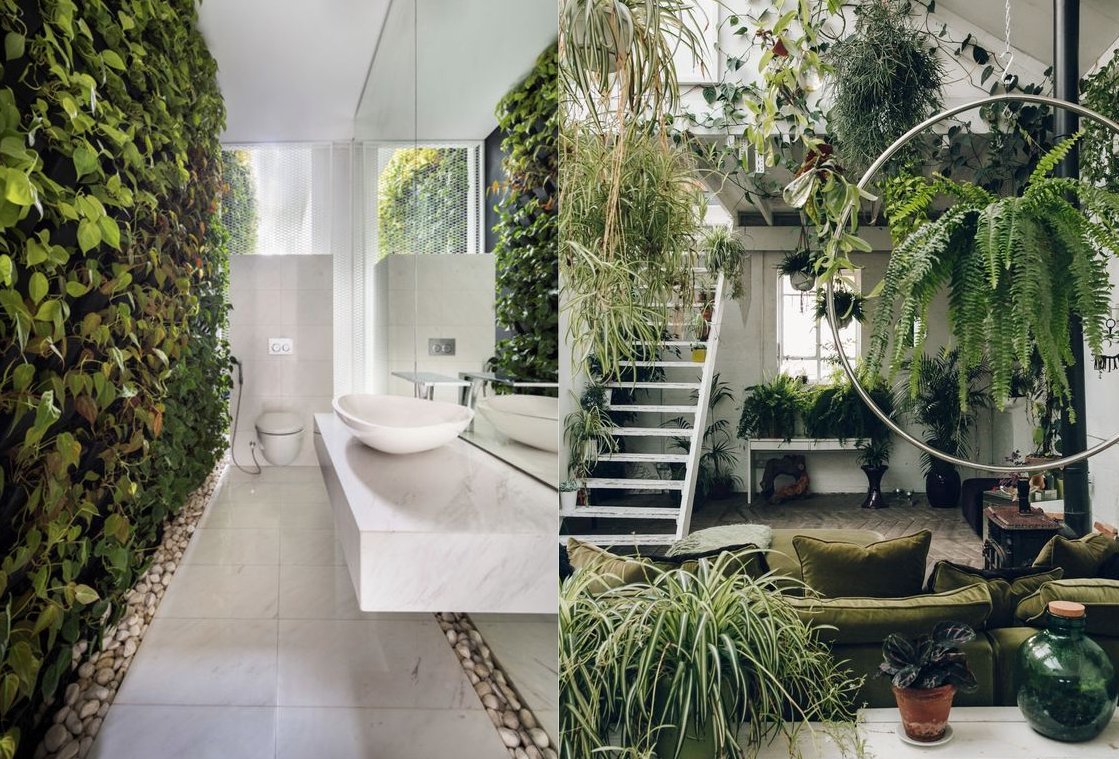 When creating nature-oriented design, it's important to avoid typical mistakes that can negate all the benefits of the biophilic approach:
When creating nature-oriented design, it's important to avoid typical mistakes that can negate all the benefits of the biophilic approach:
- Imitation instead of authenticity — Using synthetic imitations of natural materials (plastic "wood", artificial stone, fake plants) won't give the psychological effect of a genuine connection with nature. It's better to have fewer but real natural elements.
- Cluttering space with plants — Turning the interior into a jungle can lead to problems with humidity, maintenance, and create a feeling of confinement. A reasonable number of properly placed plants will create a more harmonious atmosphere.
- Ignoring lighting and microclimate — Placing plants without considering their needs for light and humidity will lead to their death. Each plant requires appropriate conditions to thrive.
- Lack of a holistic approach — Adding a few plants to an ordinary interior won't create biophilic design. It's important to comprehensively include various natural elements: light, materials, forms, plants, ventilation.
- Non-adaptability to lifestyle — Creating a beautiful but impractical space for everyday life. Biophilic design should support your lifestyle, not complicate it.
By avoiding these mistakes and adhering to the principles of authenticity, functionality, and balance, you'll create a truly effective biophilic space that will delight and support your well-being.
Challenges in Implementing Biophilic Design and Their Solutions
When creating a biophilic interior, certain difficulties may arise. Let's look at the most common problems and ways to solve them:
Allergic Reactions
Some people experience allergic reactions to certain plants, pollen, or mold.
- Solution: Choose hypoallergenic plants such as succulents, cacti, palms, and zamioculcas. Use air purifiers and monitor humidity to prevent mold growth.
Plant Care
Lack of time or experience for caring for living elements in design can lead to their death.
- Solution: Start with unpretentious plants, install automatic watering systems, or choose plants according to your schedule. Alternatively, focus on other elements of biophilic design, such as natural materials in the interior and lighting.
Limited Natural Lighting
Some rooms have minimal access to natural light.
- Solution: Use light-reflecting surfaces, light shades for walls, and special phytolamps for plants. Choose plants that feel good in low light.
Rental Housing Limitations
Tenants often cannot make substantial changes to the space.
- Solution: Use mobile and temporary biophilic solutions for the home: potted plants, portable decor elements made of natural materials, removable wallpaper with natural patterns, and flooring made of natural materials.
Financial Constraints
The cost of biophilic design can vary, and some elements can be expensive.
- Solution: Implement biophilic elements gradually, starting with the most effective ones for your space. Find out the price of a project with biophilia elements in advance and use budget alternatives described in the section on budget solutions.
Remember that biophilic design is not a one-time project but a gradual process of creating a more natural and healthy living environment. Start small and expand your approach as you solve emerging difficulties.
Regional Features and Directions of Biophilic Design
Natural room design adapts to various climatic and cultural conditions, creating unique regional variations. Let's consider several characteristic directions:
Scandinavian Biophilic Design
 It's distinguished by a minimalist approach to nature integration and a focus on maximizing natural lighting in design. Characteristic features include light wooden surfaces, neutral colors, simple lines, and a moderate number of plants adapted to low light. This style is ideal for regions with long winters and limited natural light.
It's distinguished by a minimalist approach to nature integration and a focus on maximizing natural lighting in design. Characteristic features include light wooden surfaces, neutral colors, simple lines, and a moderate number of plants adapted to low light. This style is ideal for regions with long winters and limited natural light.
Tropical Biophilic Design
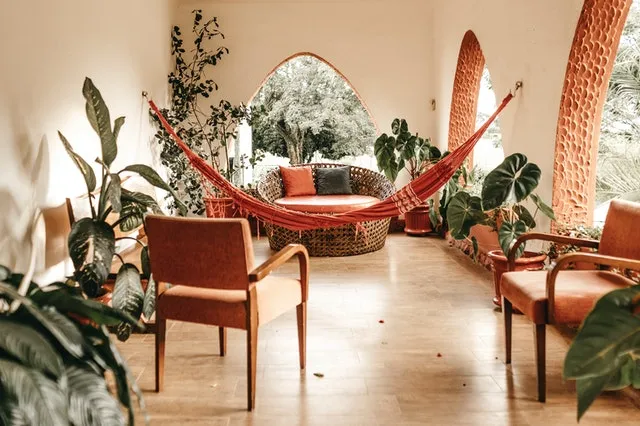 Inspired by the lush vegetation of the tropics, with a rich palette of green shades, an abundance of large-leaved plants, bright accents, and natural materials in the interior, such as rattan, bamboo, and teak. This style works well in warm humid climates or in well-lit spaces with high humidity.
Inspired by the lush vegetation of the tropics, with a rich palette of green shades, an abundance of large-leaved plants, bright accents, and natural materials in the interior, such as rattan, bamboo, and teak. This style works well in warm humid climates or in well-lit spaces with high humidity.
Mediterranean Biophilic Design
 Combines elements of biophilia in the interior with textures and colors characteristic of the region: terracotta tiles, whitewashed walls, lavender shades, and drought-resistant plants. This style emphasizes connection with outdoor spaces and often includes inner courtyards and open layouts.
Combines elements of biophilia in the interior with textures and colors characteristic of the region: terracotta tiles, whitewashed walls, lavender shades, and drought-resistant plants. This style emphasizes connection with outdoor spaces and often includes inner courtyards and open layouts.
Japanese Biophilic Design (Wabi-sabi)
 Based on recognizing beauty in the imperfection and impermanence of nature. Characterized by minimalism, asymmetry, use of unprocessed natural materials in the interior, and a careful attitude to every detail. Often includes specially designed mini-gardens, bonsai, and water design elements, creating biodiversity in design even in small spaces.
Based on recognizing beauty in the imperfection and impermanence of nature. Characterized by minimalism, asymmetry, use of unprocessed natural materials in the interior, and a careful attitude to every detail. Often includes specially designed mini-gardens, bonsai, and water design elements, creating biodiversity in design even in small spaces.
When choosing a direction for biophilic design, it's important to consider not only your personal preferences but also the climatic conditions of your region, which influence which plants will thrive in your interior and which natural elements will be most appropriate.
Comparing Biophilic Design with Other Eco-friendly Approaches
Biophilic design is one of several eco-friendly approaches to creating spaces. Understanding the differences between them will help you choose the most suitable concept for your interior:
Biophilic Design and Eco-design
Eco-design of interiors is focused on minimizing negative environmental impact through sustainable materials and energy efficiency. While biophilic design focuses on human well-being through connection with nature in the interior. They are united by the use of natural materials in the interior, but the goals and emphases differ: eco-design thinks about the planet, biophilic — about the person.
Biophilic Design and Minimalism
Minimalism aims to simplify space, remove the unnecessary, and focus on functionality. Natural room design can be combined with minimalism but emphasizes adding natural elements that may seem "redundant" from the point of view of strict minimalism.
Biophilic Design and Organic Architecture
Organic architecture, developed by Frank Lloyd Wright, strives for harmony between human habitation and the surrounding world through form and function. Biophilic design goes further, actively integrating living elements in design and their imitations to enhance psychological and physiological well-being.
Biophilic Design and Sustainable Development
Sustainable development in the interior aims to create spaces that can be maintained long-term without harming resources. Biophilia at home can be a component of a sustainable approach, adding an aspect of human well-being to environmental sustainability.
An integrated approach often becomes the optimal solution, combining principles of biophilic design with elements of other eco-friendly concepts, creating spaces that are good for both people and the planet.
Cost and Practical Aspects
Developing a biophilic interior can vary in cost depending on the scale of the project and materials used. The minimum budget for implementing biophilia elements starts from small investments in plants and natural materials in the interior, while a full-fledged biophilic renovation may require more serious investments.
Biophilic design services are becoming increasingly accessible as the number of specialists in biophilic design grows. You can order biophilic design as a complete project or choose separate consultations. However, many elements can be implemented independently, starting small — with a few plants, natural textures, and proper use of natural light.
It's important to consider not only the initial costs but also the long-term benefits: reduced energy costs, improved health, and increased productivity often compensate for the cost of a project with biophilia elements. When planning a budget, it's worth paying attention to turnkey biophilic solutions, which can be more economical than phased implementation.
Biophilic Design for Offices and Commercial Spaces
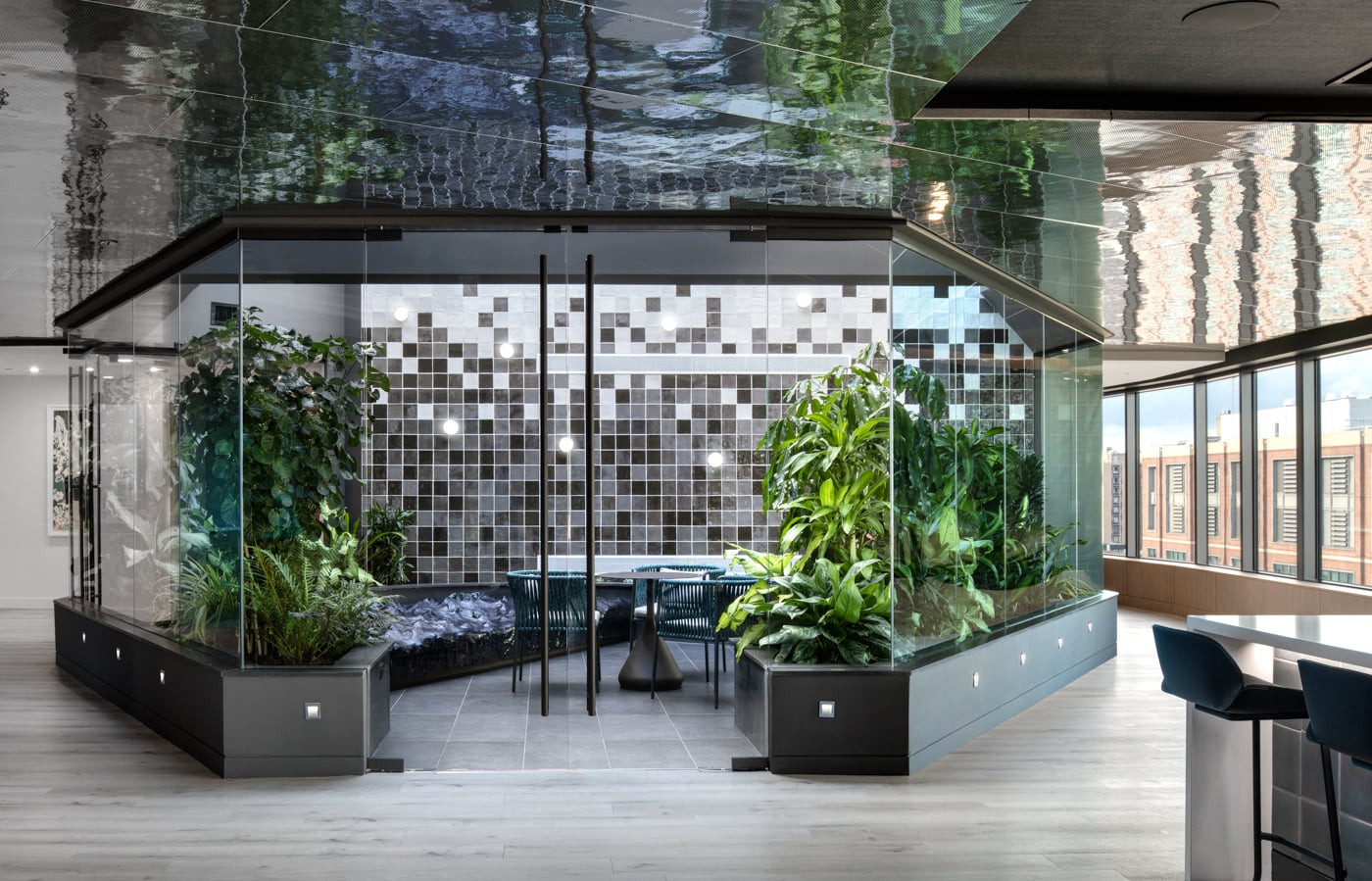 Nature-oriented design in work and public spaces has special significance, considering the amount of time people spend in them and the influence of the environment on efficiency and well-being:
Nature-oriented design in work and public spaces has special significance, considering the amount of time people spend in them and the influence of the environment on efficiency and well-being:
Offices and Work Spaces
Biophilic design for office spaces not only improves aesthetics but also brings measurable business results:
- Reduction of employee stress levels by 30-60%
- Increase in productivity by 8-15%
- Reduction of sick days by 10-20%
- Reduction of staff turnover by 15-25%
- Improvement in creativity and problem solving by 15%
Key elements for office spaces include plant walls in the interior, diverse working areas with access to natural light, use of natural materials in the interior for finishing and furniture, as well as creating relaxation zones with elements of biophilia in the interior.
Educational and Medical Institutions
In schools, universities, and medical institutions, biophilic elements show impressive results:
- Increase in learning speed by 20-25% in educational institutions
- Reduction of anxiety levels in patients by 30-40%
- Acceleration of recovery in hospitals by 8.5%
- Reduction in the need for painkillers by 22%
Hospitality Business and Retail
Hotels and stores that have implemented biophilic design and vertical greening of premises note:
- Increase in average check by 15-20% in commercial spaces
- Increase in visitor stay time by 30%
- Growth of premium rates in hotels with biophilic elements by 10-15%
- Increase in customer satisfaction and increase in repeat visits
"In the corporate environment, biophilic design is not a luxury but an investment that pays off. We see how companies investing in creating healthy spaces with elements of nature gain a competitive advantage not only in financial indicators but also in attracting and retaining talented employees. In the modern world, where there is a struggle for intellectual capital, the quality of the working environment becomes a decisive factor."
Budget Solutions for Biophilic Design
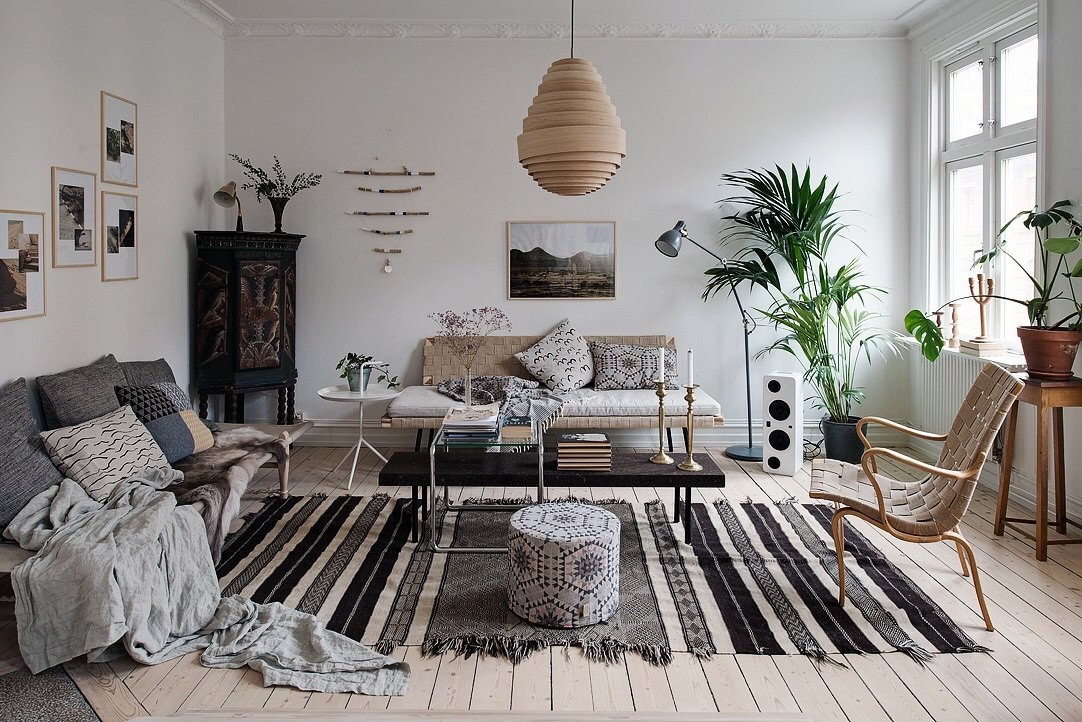 Creating a connection with nature in the interior doesn't necessarily require large expenses. We offer economical ways to implement biophilic elements in various spaces:
Creating a connection with nature in the interior doesn't necessarily require large expenses. We offer economical ways to implement biophilic elements in various spaces:
The table below presents various options for implementing biophilic elements for different budgets and needs:
| Biophilia Element | Budget Option | Medium Option | Alternative Solution |
|---|---|---|---|
| Plants and Greening | Unpretentious plants (succulents, snake plant, pothos) with propagation by cuttings | Group compositions of plants of different heights, hanging plants | Natural materials (cones, branches, stones) for decorative compositions |
| Natural Lighting | Strategic placement of mirrors to reflect natural light | Replacing thick curtains with light linen or cotton drapes | LED lighting with a color temperature close to daylight |
| Natural Materials | Decorative pillows with plant patterns, small wooden accessories | Updating one piece of furniture to an analog made of natural materials | Self-creation of artworks using natural motifs |
| Colors and Patterns | Repainting one accent wall in a natural shade | Wallpaper with natural patterns on one wall | Adding plant prints through textiles (bedspreads, throws) |
Remember that biophilic design is not so much about the quantity of natural elements as about their quality and proper placement. Even with a limited budget, you can create a space that will positively affect your well-being and wellness.
"The true luxury of modern housing is not gold or marble, but living nature and clean air. Biophilic design is democratic: even a small pot with a plant can change the feeling of space, and a view of greenery outside the window is worth more than any designer solutions. We design not just a beautiful picture, but a healthy living environment that helps a person thrive."
Conclusion
Biophilic interior design is more than a fashion trend; it's a return to the natural needs of humans through modern design solutions. Integrating nature into the interior through elements of biophilia in the interior can start small — with a few plants or natural materials in the interior, gradually transforming the space into a harmonious, healthy, and inspiring environment.
Regardless of budget and room size, there are always ways to bring natural elements in design into your home or office. Numerous studies confirm that connection with nature in the interior is not only an aesthetic choice but also a significant investment in one's own health, well-being, and productivity.
By adapting the principles of biophilic design to your conditions, avoiding common mistakes, and taking into account regional characteristics, you'll be able to create a space that not only looks attractive but also supports physical and psychological balance. Start creating a biophilic interior today, and you'll quickly feel how biophilia at home changes your perception of space and attitude to everyday life in it.
